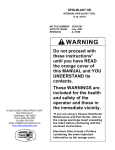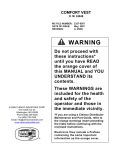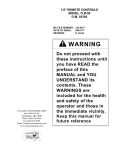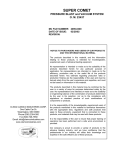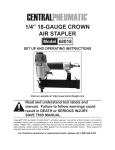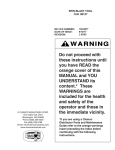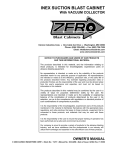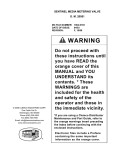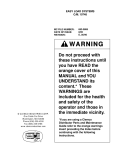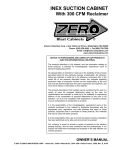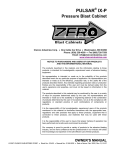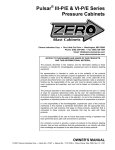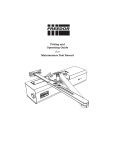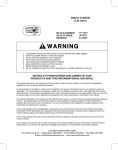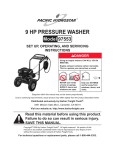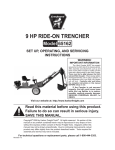Download Manual – 1 cubic foot
Transcript
SINGLE CHAMBER BLAST MACHINE MODEL 1028 and 1042 O. M. 04124 MC FILE NUMBER: 106/0976 DATE OF ISSUE: 01/15/77 REVISION: I, 09/04 WARNING © 2004 CLEMCO INDUSTRIES CORP. One Cable Car Dr. Washington, MO 63090 Phone (636) 239-4300 Fax (636) 239-0788 Email: [email protected] www.clemcoindustries.com ® Do not proceed with these instructions until you have READ the preface of this MANUAL and YOU UNDERSTAND its contents. These WARNINGS are included for the health and safety of the operator and those in the immediate vicinity. Keep this manual for future reference. PREFACE GENERAL INSTRUCTIONS WARNING • • • Described herein are some, BUT NOT ALL, of the major requirements for safe and productive use of blast machines, remote control systems, operator respirator assemblies, and related accessories. Completely read ALL instruction manuals prior to using equipment. Read and follow ALL instructions before using this equipment. Failure to comply with ALL instructions can result in serious injury or death. In the event that the user, or any assistants of the user of this equipment cannot read or cannot completely understand the warnings and information contained in these instructions, the employer of the user and his assistants must thoroughly educate and train them on the proper operation and safety procedures of this equipment. The user's work environment may include certain HAZARDS related to the abrasive blasting operation. Proper protection for the blaster, as well as anyone else that may be EXPOSED to the hazards generated by the blasting process, is the responsibility of the user and/or the employer. Operators MUST consult with their employer about what hazards may be present in the work environment including, but not limited to, exposure to dust that may contain TOXIC MATERIALS due to the presence of silica, cyanide, arsenic or other toxins in the abrasive, or materials present in the surface to be blasted such as lead or heavy metals in coatings. The environment may also include fumes that may be present from adjacent coatings application, contaminated water, engine exhaust, chemicals, and asbestos. The work area may include PHYSICAL HAZARDS such as an uneven work surface, poor visibility, excess noise, and electrical hazards. The operator MUST consult with his employer on the identification of potential hazards, and the appropriate measures that MUST be taken to protect the blaster and others that might be exposed to these hazards. NOTICE TO PURCHASERS AND USERS OF OUR PRODUCTS AND THIS INFORMATIONAL MATERIAL The products described in this material, and the information relating to those products, is intended for knowledgeable, experienced users of abrasive blasting equipment. No representation is intended or made as to the suitability of the products described herein for any particular purpose or application. No representations are intended or made as to the efficiency, production rate, or the useful life of the products described herein. Any estimate regarding production rates or production finishes are the responsibility of the user and must be derived solely from the user’s experience and expertise, and must not be based on information in this material. ALL machines, components and accessories MUST be installed, tested, operated and maintained only by trained, knowledgeable, experienced users. The products described in this material may be combined by the user in a variety of ways for purposes determined solely by the user. No representations are intended or made as to the suitability or engineering balance of the combination of products determined by the user in his selection, nor as to the compliance with regulations or standard practice of such combinations of components or products. DO NOT modify or substitute any Clemco parts with other types or brands of equipment. Unauthorized modification and parts substitution on supplied air respirators is a violation of OSHA regulations and voids the NIOSH approval. Abrasive Blast Equipment is only a component of the range of equipment used in an abrasive blasting job. Other products may include an air compressor, abrasive, scaffolding, hydraulic work platforms or booms, paint spray equipment, dehumidification equipment, air filters and receivers, lights, ventilation equipment, parts handling equipment, specialized respirators, or equipment that while offered by Clemco may have been supplied by others. Each manufacturer and supplier of the other products used in the abrasive blasting job must be contacted for information, training, instruction and warnings with regard to the proper and safe use of their equipment in the particular application for which the equipment is being used. The information provided by Clemco is intended to provide instruction only on Clemco products. All operators must be trained in the proper, safe, use of this equipment. It is the responsibility of the users to familiarize themselves with, and comply with, all appropriate laws, regulations, and safe practices that apply to the use of these products. Consult with your employer about training programs and materials that are available. OPERATIONAL INSTRUCTIONS OPERATOR SAFETY EQUIPMENT WARNING • • • Our company is proud to provide a variety of products to the abrasive blasting industry, and we have confidence that the professionals in our industry will utilize their knowledge and expertise in the safe efficient use of these products. Blast operators and others working in the vicinity of abrasive blasting must always wear properlymaintained, NIOSH-approved, respiratory protection appropriate for the job site hazards. DO NOT USE abrasives containing more than one percent crystalline (free) silica. Ref. NIOSH Alert #92-102 Inhalation of toxic dust (crystalline silica, asbestos, lead paint and other toxins) can lead to serious or fatal disease (silicosis, asbestosis, lead or other poisoning). • ALWAYS wear NIOSH-approved supplied-air respirators as required by OSHA, in the presence of any dust including, but not limited to, handling or loading abrasive; blasting or working in the vicinity of blast jobs; and cleanup of expended I PREFACE abrasive. Prior to removing respirator, an air monitoring instrument should be used to determine when surrounding atmosphere is clear of dust and safe to breathe. equipment. If controls are altered, involuntary activation, which may cause serious injury, can occur. • Inspect the air control orifice DAILY for cleanliness. NEVER use welding hose in place of twinline control hose. The internal diameter and rubber composition are UNSAFE for remote control use. • NIOSH-approved, supplied-air respirators are to be worn ONLY in atmospheres: • NOT IMMEDIATELY dangerous to life or health and, • from which a user can escape WITHOUT using the respirator. • UNLESS OTHERWISE SPECIFIED, maximum working pressure of blast machines and related components MUST NOT exceed National Board approved 125 psig (8.5 BAR). • Clemco supplied-air respirators DO NOT REMOVE OR PROTECT AGAINST CARBON MONOXIDE (CO) OR ANY OTHER TOXIC GAS. Carbon monoxide and toxic gas removal and/or monitoring device must be used in conjunction with respirator to insure safe breathing air. • NEVER weld on blast machine. Welding may affect dimensional integrity of steel wall and WILL VOID National Board approval. • Air supplied to respirator MUST BE AT LEAST GRADE D QUALITY as described in Compressed Gas Association Commodity Specification G-7.1, and as specified by OSHA Regulation 1910.139 (d). • Point nozzle ONLY at structure being blasted. High velocity abrasive particles WILL inflict serious injury. Keep unprotected workers OUT of blast area. • ALWAYS locate compressors to prevent contaminated air (such as CO from engine exhaust) from entering the air intake system. A suitable in-line air purifying sorbent bed and filter or CO Monitor should be installed to assure breathing air quality. • NEVER attempt to manually move blast machine when it contains abrasive. EMPTY machines, up to 6 cu. ft.(270kg) capacity, are designed to be moved: • on flat, smooth surfaces by AT LEAST two people; • with the Clemco "Mule"; or • with other specially designed machine moving devices. • ALWAYS use a NIOSH-approved breathing air hose to connect an appropriate air filter to the respirator. Use of a nonapproved air hose can subject the operator to illness caused by the release of chemical agents used in the manufacture of nonapproved breathing air hose. • Larger empty blast machines or ANY blast machine containing abrasive MUST be transported by mechanical lifting equipment. • ALWAYS check to make sure air filter and respirator system hoses are NOT CONNECTED to in-plant lines that contain nitrogen, acetylene or any other non-breathable gas. NEVER use oxygen with air line respirators. NEVER modify air line connections to accommodate air filter/respirator breathing hose WITHOUT FIRST testing content of the air line. FAILURE TO TEST THE AIR LINE MAY RESULT IN DEATH TO THE RESPIRATOR USER. AIR HOSE, BLAST HOSE, COUPLINGS, AND NOZZLE HOLDERS • Air hose, air hose fittings and connectors at compressors and blast machines MUST be FOUR times the size of the nozzle orifice. Air hose lengths MUST be kept as short as possible AND in a straight line. Inspect DAILY and repair leakage IMMEDIATELY. • Blast hose inside diameter MUST be THREE to FOUR times the size of the nozzle orifice. AVOID sharp bends that wear out hose rapidly. Use SHORTEST hose lengths possible to reduce pressure loss. Check blast hose DAILY for soft spots. Repair or replace IMMEDIATELY. • Respirator lenses are designed to protect against rebounding abrasive. They do not protect against flying objects, glare, liquids, radiation or high speed heavy materials. Substitute lenses from sources other than the original respirator manufacturer will void NIOSH-approval of this respirator. • ALWAYS cut loose hose ends square when installing hose couplings and nozzle holders to allow uniform fit of hose to coupling shoulder. NEVER install couplings or nozzle holders that DO NOT provide a TIGHT fit on hose. ALWAYS use manufacturers recommended coupling screws. BLAST MACHINES AND REMOTE CONTROLS • Replace coupling gaskets FREQUENTLY to prevent leakage. Abrasive leakage can result in dangerous coupling failure. ALL gaskets MUST be checked SEVERAL times during a working day for wear, distortion and softness. WARNING • • ALWAYS equip abrasive blast machines with remote controls. Abrasive blast machine operators must wear NIOSHapproved supplied-air respirators (ref: OSHA regulations 1910.94, 1910.132, 1910.139 and 1910.244). • Install safety pins at EVERY coupling connection to prevent accidental disengagement during hose movement. • ALWAYS attach safety cables at ALL air hose AND blast hose coupling connections. Cables relieve tension on hose and control whipping action in the event of a coupling blow-out. • NEVER modify OR substitute remote control parts. Parts from different manufacturers are NOT compatible with Clemco II PREFACE price, as set forth below: 1. Seller makes no warranty with respect to products used other than in accordance hereunder. 2. On products seller manufactures, seller warrants that all products are to be free from defects in workmanship and materials for a period of one year from date of shipment to buyer, but no warranty is made that the products are fit for a particular purpose. 3. On products which seller buys and resells pursuant to this order, seller warrants that the products shall carry the then standard warranties of the manufacturers thereof, a copy of which shall be made available to customer upon request. 4. The use of any sample or model in connection with this order is for illustrative purposes only and is not to be construed as a warranty that the product will conform to the sample or model. 5. Seller makes no warranty that the products are delivered free of the rightful claim of any third party by way of patent infringement or the like. 6. This warranty is conditioned upon seller’s receipt within ten (10) days after a buyer’s discovery of a defect, of a written notice stating in what specific material respects the product failed to meet this warranty. If such notice is timely given, seller will, at its option, either modify the product or part to correct the defect, replace the product or part with complying products or parts, or refund the amount paid for the defective product, any one of which will constitute the sole liability of seller and a full settlement of all claims. No allowance will be made for alterations or repairs made by other than those authorized by seller without the prior written consent of seller. Buyer shall afford seller prompt and reasonable opportunity to inspect the products for which any claim is made as above stated. MAINTENANCE • ALWAYS shut off compressor and depressurize blast machine BEFORE doing ANY maintenance. • Always check and clean ALL filters, screens and alarm systems when doing any maintenance. • ALWAYS cage springs BEFORE disassembling valves IF spring-loaded abrasive control valves are used. • ALWAYS completely follow owner's manual instructions and maintain equipment at RECOMMENDED intervals. ADDITIONAL ASSISTANCE • Training and Educational Programs. Clemco Industries Corp. offers a booklet, Blast-Off 2, developed to educate personnel on abrasive blast equipment function and surface preparation techniques. Readers will learn safe and productive use of machines, components and various accessories, including selection of abrasive materials for specific surface profiles and degrees of cleanliness. • The Society for Protective Coatings (SSPC) offers a video training series on protective coatings including one entitled "Surface Preparation." For loan or purchase information, contact SSPC at the address shown below. TECHNICAL DATA AND RESEARCH COMMITTEES • The following associations offer information, materials and videos relating to abrasive blasting and safe operating practices. The Society for Protective Coatings (SSPC) 40 24th Street, Pittsburgh PA 15222-4643 Phone: (412) 281-2331 • FAX (412) 281-9992 Email: [email protected] • Website: www.sspc.org National Association of Corrosion Engineers (NACE) 1440 South Creek Drive, Houston TX 77084 Phone: (281) 228-6200 • FAX (281) 228-6300 Email: [email protected] • Website: www.nace.org American Society for Testing and Materials (ASTM) 100 Barr Harbor Dr., West Conshohocken, PA 19428 Phone (610) 832-9500 • FAX (610) 832-9555 Email: [email protected] • Website: www.astm.org Except as expressly set forth above, all warranties, express, implied or statutory, including implied warranty of merchantability, are hereby disclaimed. DAILY SET-UP CHECK LIST WARNING • • • • NOTICE • This equipment is not intended to be used in an area that might be considered a hazardous location as described in the National Electric Code NFPA 70 1996, article 500. • WARRANTY The following is in lieu of all warranties express, implied or statutory and in no event shall seller or its agents, successors, nominees or assignees, or either, be liable for special or consequential damage arising out of a breach of warranty. This warranty does not apply to any damage or defect resulting from negligent or improper assembly or use of any item by the buyer or its agent or from alteration or attempted repair by any person other than an authorized agent of seller. All used, repaired, modified or altered items are purchased “as is” and with all faults. In no event shall seller be liable for consequential or incidental damages. The sole and exclusive remedy of buyer for breach of warranty by seller shall be repair or replacement of defective parts or, at seller’s option, refund of the purchase ALL piping, fittings and hoses MUST be checked DAILY for tightness and leakage. ALL equipment and components MUST be thoroughly checked for wear. ALL worn or suspicious parts MUST be replaced. ALL blast operators MUST be properly trained to operate equipment. ALL blast operators MUST be properly outfitted with abrasive resistant clothing, safety shoes, leather gloves and ear protection. BEFORE blasting ALWAYS use the following check list. □ 1. PROPERLY MAINTAINED AIR COMPRESSOR sized to provide sufficient volume (cfm) for nozzle and other tools PLUS a 50% reserve to allow for nozzle wear. Use large compressor outlet and large air hose (4 times the nozzle orifice size). FOLLOW MANUFACTURERS MAINTENANCE INSTRUCTIONS. □ 2. BREATHING AIR COMPRESSOR (oil-less air pump) capable of providing Grade D Quality air located in a dust free, contaminant free area. If oil-lubricated air compressor is used to supply respirator, it should have high temperature monitor and CO monitor or both. If CO monitor is not used, air MUST III PREFACE be tested FREQUENTLY to ensure proper air quality. □ 8. BLAST HOSE with ID 3 to 4 times the nozzle orifice. Lines MUST be run AS STRAIGHT AS POSSIBLE from machine to work area with NO sharp bends. Check DAILY for internal wear and external damage. □ 3. Clean, properly maintained NIOSH-APPROVED SUPPLIED-AIR RESPIRATOR. ALL components should ALWAYS be present. NEVER operate without inner lens in place. Thoroughly inspect ALL components DAILY for cleanliness and wear. ANY substitution of parts voids NIOSH approval i.e. cape, lenses, breathing hose, breathing air supply hose, air control valve, cool air or climate control devices. □ 9. HOSE COUPLINGS, NOZZLE HOLDERS fitted SNUGLY to hose end and installed using PROPER coupling screws. Coupling lugs MUST be snapped FIRMLY into locking position. Gasket MUST form positive seal with safety pins inserted through pin holes. Check gaskets and replace if ANY sign of wear, softness or distortion. ALWAYS install safety cables at every connection to prevent disengagement. Check nozzle holder for worn threads. NEVER MIX DIFFERENT BRANDS OF COMPONENTS. Check each of these components DAILY. □ 4. OSHA required BREATHING AIR FILTER for removal of moisture and particulate matter from breathing air supply. THIS DEVICE DOES NOT REMOVE OR DETECT CARBON MONOXIDE (CO). ALWAYS USE CO MONITOR ALARM. □ 5. ASME CODED BLAST MACHINE sized to hold 1/2 hour abrasive supply. ALWAYS ground machine to eliminate static electricity hazard. Examine pop up valve for alignment. Blast machine MUST be fitted with a screen to keep out foreign objects and a cover to prevent entry of moisture overnight. □ 10. Inspect NOZZLE and GASKET DAILY for wear. Replace nozzle when 1/16" larger than original size or if liner appears cracked. Check nozzle threads for wear. □ 11. Use abrasive that is properly sized and free of harmful substances; such as, free silica, cyanide, arsenic or lead. Check material data sheet for presence of toxic or harmful substances. □ 6. AIR LINE FILTER installed AS CLOSE AS POSSIBLE to machine inlet. Sized to match inlet piping or larger air supply line. Clean filter DAILY. Drain OFTEN. □ □ 12. Test surface to be blasted for toxic substances. Take appropriate, and NIOSH required, protective measures for operator and bystanders which pertain to substances found on the surface to be blasted. 7. REMOTE CONTROLS MUST be in PERFECT operating condition. ONLY use APPROVED spare parts, including twin- line hose. DAILY: test system operation and check button bumper and spring action of lever and lever lock. DO NOT USE WELDING HOSE. 1 Air Compressor 11. Silica-free Abrasive 5. ASME Coded Blast Machine 7. Remote Controls 2. Breathing Air Compressor (or) 2. Ambient Air Pump for low pressure respirator 3. NIOSH Approved Supplied-Air Respirator 6. Air Line Filter 10. Appropriately Sized Nozzle 4. CPF Air-Filter 8. Blast Hose 9. Hose Couplings and Safety Cables IV MODEL 1028 & 1042 BLAST MACHINE 1.0 INTRODUCTION 1.1 Scope 1.1.1 These instructions cover set-up, operation, maintenance, troubleshooting, and replacement parts for Clemco Model 1028 (0.5 cu ft. capacity) and Model 1042 (1.0 cu ft. capacity) blast machines. The instructions cover remote controlled machines (when an operator controls blasting from a pneumatically operated control handle mounted at the nozzle), and manually controlled machines (a blast machine fitted with simple ball valves at the inlet and outlet, that must be manually opened and closed to start and stop the blast process) The following separate manuals are included with blast machine when furnished with remote controls. TLR-50 Remote Controls, Manual No. .......... 03358 RLX Control Handle, Manual No. ................... 10574 1.1.2 OSHA requires remote controls on all blast machines when a blast operator commands the nozzle. Manually controlled blast machines are allowed only in cases where a machine is connected to a fixed nozzle or tool that is enclosed and separated from the operator and surrounding personnel. If this machine is intended for use with a blast operator and it is not equipped with remotes controls, contact a Clemco distributor for a TLR50 remote control system (Stock No. 02518). 1.1.3 Blast operators and personnel involved with the blast machine operation must be trained in the safe operation of the blast machine and blasting accessories. All personnel involved with the abrasive blasting process must be made aware of the hazards associated with abrasive blasting. The Clemco booklet ″Abrasive Blasting Safety Practices″ Stock No. 22090, is included with every blast machine, and contains important safety information about abrasive blasting that may not be included in equipment operation manuals. Additional copies are available from Clemco Industries. Visit www.clemcoindustries.com 1.2 Safety Alerts 1.2.1 Clemco uses safety alert signal words, based on ANSI Z535.4-1998, to alert the user of a potentially hazardous situation that may be encountered while operating this equipment. ANSI's definitions of the signal words are as follows: This is the safety alert symbol. It is used to alert the user of this equipment of potential personal injury hazards. Obey all safety messages that follow this symbol to avoid possible injury or death. Page 1 CAUTION Caution used without the safety alert symbol indicates a potentially hazardous situation which, if not avoided, may result in property damage. CAUTION Caution indicates a potentially hazardous situation which, if not avoided, may result in minor or moderate injury. WARNING Warning indicates a potentially hazardous situation which, if not avoided, could result in death or serious injury. DANGER Danger indicates an imminently hazardous situation which, if not avoided, will result in death or serious injury. 1.3 Description 1.3.1 The primary components of the blast machine are shown in Figure 1. 1.3.2 Clemco blast machines (pressure vessels) are manufactured to American Society of Mechanical Engineers (ASME) standards, as described in Section VII, Div. 1, and carry a National Board certification. It is the owner’s responsibility to maintain the integrity of the vessel as may be required by some states. This may include regular inspection and hydrostatic testing as described in National Board Inspection Code and Jurisdictional Regulations and /or Laws. WARNING Welding, grinding, or drilling on the blast machine could weaken the vessel. Compressed air pressure could cause a weakened blast machine to rupture, resulting in death or serious injury. Welding, grinding, or drilling on the blast machine vessel, without a National Board R stamp voids the ASME and National Board certification. MODEL 1028 & 1042 BLAST MACHINE Page 2 Model 1028 , 0.5 Cu Ft Shown with remote controls Outlet Valve Inlet Valve Air-Inlet Connection Model 1042, 1.0 Cu Ft. Shown with manual valves Manual Outlet Valve Manual Inlet Valve Air-Inlet Connection Optional Screen Pop-up Valve Choke Valve Inspection Door Abrasive Metering valve Blast-Hose Connection Figure 1 1.3.3 All welding repairs done on the vessel must be performed by certified welders, at shops holding a National Board R Stamp. Welding performed by any welder not properly qualified per the ASME Code voids ASME and National Board certification of the vessel. 1.3.4 This blast machine is rated for a maximum of 125 psi (pounds per square inch); do not exceed the rated pressure. WARNING Excessive compressed air pressure could cause a blast machine to rupture. To prevent serious injury or death, do not exceed the rated pressure of the blast machine vessel. 1.3.5 OSHA does not require pressure relief valves on blast machines when air compressors supplying air to the blast machines are built to ASME(1) specifications and comply with OSHA(2) regulations. ASME Manual section VIII, Division 1, UG-125, paragraph A90 (g) states that pressure relief valves or protective devices "...need not be installed directly on a pressure vessel when the source of pressure is external to the vessel and is under such positive control that the pressure in the vessel cannot exceed the maximum allowable working pressure at the operating temperature...". OSHA regulation 1910.169 refers to the above ASME code when describing the necessity of pressure relief valves on compressed air equipment. DO NOT operate blast machines with air compressors that are not equipped with properly functioning pressure relief valves. (1) American Society of Mechanical Engineers, Boiler and Pressure Vessel Code, 1989 (2) Occupational Safety and Health Administration, 29 CFR 1910, Subpart M - Compressed Gas and Compressed Air Equipment. MODEL 1028 & 1042 BLAST MACHINE Page 3 Compressed Air and Abrasives Consumption Consumption rates are based on abrasives that weigh 100 pounds per cubic foot Nozzle Orifice Size (in.) No. 2 1/8" No. 3 3/16" No. 4 1/4" • • • • Pressure At The Nozzle (psi) 50 11 67 2.5 26 150 6 47 268 11 60 13 77 3 30 171 7 54 312 12 70 15 88 3.5 33 196 8 61 354 14 80 17 101 4 38 216 9 68 408 16 90 19 112 4.5 41 238 10 74 448 17 100 20 123 5 45 264 10 81 494 18 125 25 152 5.5 55 319 12 98 608 22 Air, Power and Abrasive Requirements Air (cfm) Abrasive lbs/hr) Compressor (hp) Air (cfm) Abrasive (lbs/hr) Compressor (hp) Air (cfm) Abrasive (lbs/hr) Compressor (hp) Air requirements were measured by a flow meter under actual blasting conditions, and are therefore lower than figures for air alone, with no abrasive. Horsepower requirements are based on 4.5 cfm per horsepower. Figures are for reference only, and may vary for different working conditions. Several variables, including metering valve adjustments, can affect abrasive flow. Figures show approximate compressed air and abrasive consumption when nozzles are new. Consumption will increase as the nozzle wears. Figure 2 1.3.6 Compressed-air Requirements 1.3.6.1 The size of the compressor required depends on the orifice size of the nozzle and blasting pressure. Unless specified otherwise, blast machine packages are supplied with a 1/4" orifice nozzle. Nozzles larger than 1/4" are not recommended because the accelerated velocity rapidly wears the blast hose. 1.3.6.2 Refer to the table in Figure 2 to determine cfm requirements. The table shows air consumption of nozzles when new. It does not show the recommended compressor size. As nozzles wear, they will consume 70% to 80% more air. Consult with a compressor supplier for suggested compressor size based on the air consumption of the next larger orifice size. 1.3.7 Remote Controls 1.3.7.1 Separate manuals are provided for the operation, maintenance, and replacement parts for the TLR-50 remote controls (Manual Stock No. 03358) and RLX control handle (Manuals Stock No. 10574). Refer to those manuals for set-up and operation of the remote control system. 1.3.8 Air Filter, Optional 1.3.8.1 The optional air filter at the blast machine inlet removes water condensed in the compressed air line. Its use is especially important in areas of high humidity, or when fine-mesh abrasive is used. Moisture causes media to clot and inhibits free flow through the metering valve. See Section 7.1 for accessories. If moisture problems persist, an air dryer may be required. 2.0 INITIAL SET-UP 2.1 Blast Machine Set-Up 2.1.2 Install an air supply hose fitting to the inlet valve (or filter), that is compatible with the compressed-air supply hose. See Section 3.2.2. 2.2 Remote Control Set-Up 2.2.1 Refer to the remote control manual for set-up and operation of the control system. MODEL 1028 & 1042 BLAST MACHINE 3.0 OPERATION 3.1 Transporting and moving 3.1.1 Transporting a blast machine 3.1.1.1 Always empty the machine before transporting. Transporting a machine containing abrasive may increase the weight to an unsafe handling limit, and could cause abrasive to settle in the piping. WARNING • Always empty the blast machine before lifting or hoisting. • Never hoist the machine by the handle or piping, or with a sling through the handle or piping. • When transporting a machine on a pallet, always securely attach the machine to a sturdy pallet. • Always securely anchor the machine to the transport vehicle. • Failure to observe these warnings could result in serious injury or death. 3.1.2 Moving a blast machine WARNING Page 4 WARNING If twist-on type air hose couplings are used, they must be secured by safety lock pins or wires to prevent accidental disconnection while under pressure. Hose disconnection while under pressure could cause serious injury. 3.2.3 Make sure the coupling gaskets are in place and in good condition before connecting the blast hose to the quick coupling on the blast machine. To prevent accidental separation during blasting, use safety lockpins or safety wire to lock the couplings together. 3.2.4 Make sure that all hose connections are secure. Install safety lock pins on all quick coupling. Use lock pins and safety cables on all quick coupling connections to help prevent accidental separation of hoses. Lock pins and safety cables are listed in Section 7.3. WARNING Hose disconnection while under pressure could cause serious injury or death. Use safety lockpins and safety cables on all coupling connections to help prevent hose couplings from accidental disconnection. 3.2.5 Make sure the choke valve is open (handle inline with the piping). Never manually move a blast machine when it contains abrasive. Empty (model 1028 and 1042) machines may be moved when the following criteria are met. 3.2.6 Close the abrasive metering valve. The closed position is when the handle is pointing toward the pipe nipples in the metering valve. 3.1.2.1 An empty machine may be moved manually, on level flat surfaces. 3.2.7 Close the air valve on the compressor. Start the compressor, and bring it up to operating temperature and pressure. The pressure must not exceed 125 psi. 3.1.2.2 Move the machine by pushing it in a forward direction. Do not back-up while moving the machine, as potential tripping hazards cannot be seen. 3.2.8 Load abrasive into the machine by following the instructions in Section 3.6. 3.2 3.2.9 If the machine is equipped with manual valves, make sure the inlet valve is closed (handle perpendicular to the valve). Set-up 3.2.1 Locate the compressor upwind and/or away from the blasting operation to prevent contaminated air from entering the compressor intake. 3.2.2 Connect a 3/4" ID or larger air line from the compressor to the air supply hose connector previously installed on the blast machine inlet. NOTE: If the air line supplies air to other pneumatic tools, install isolation valves to enable depressurization of each line for service. 3.2.10 If the machine is equipped with remote controls, make sure the control handle is in the “up” (no blast) position. 3.2.11 Slowly open the compressor air valve to pressurize the air supply line. Listen for noise that indicates any open lines or leaks. MODEL 1028 & 1042 BLAST MACHINE 3.3 Manual Blasting. See Section 3.4 for blasting with remote controls. 3.3.1 Make sure the ventilation system is running. 3.3.2 Make sure the nozzle fixture is secure and that the nozzle is directed only toward objects intended to be blast cleaned. WARNING OSHA requires remote controls on all blast machines when an operator controls the nozzle. If a blast operator is controlling the nozzle of a manually controlled blast machine, contact a Clemco distributor for a compatible remote control system. Ignoring this warning places the operator at risk of severe injury or death from accidents that could occur from an uncontrolled blast nozzle. 3.3.3 Make sure the blasting area is contained. 3.3.4 Do not allow anyone within 10 feet of the blast machine except machine tenders, who are appropriately fitted with approved protective equipment. WARNING All persons except for the machine tender must stay clear of the blast machine. The tender may pressurize or depressurize the machine at any time. The noise generated by the sudden release of compressed air when the machine is pressurized or depressurized, may startle bystanders, and may vent abrasive under pressure. Either condition could result in injury. The machine tender must wear a suitable, approved respirator, plus approved eye, face, and hearing protection. 3.3.5 The machine tender closes the outlet valve, and while standing back and facing away from the concave filling head, opens the inlet valve. This action causes the pop-up valve to seal off the filling port and pressurizes the blast machine. 3.3.6 If the abrasive metering valve is closed as instructed in Section 3.2.6, only air will exit the nozzle. Adjust the metering valve per Section 3.5. Page 5 WARNING Never leave a pressurized machine unattended. If an emergency occurs, such as a burst blast hose, shut-down the machine immediately. 3.3.7 To stop blasting, the machine tender closes the inlet valve, and while standing back and facing away from the concave head and outlet valve, quickly opens the outlet valve. The pop-up valve drops when air is expelled from the machine and pressure equalizes. 3.4 Blasting with Remote Controls. See Section 3.3 for manual blasting. 3.4.1 Refer to the remote control manual to ensure the machine is correctly set-up and ready for blasting. 3.4.2 Operators must wear appropriate protective gear, including: abrasive-resistant clothing, leather gloves, hearing protection, and a NIOSH-approved, and properly maintained supplied-air respirator. WARNING Abrasive blasting produces harmful dust. Everyone in the blasting area must wear a properly fitted and properly maintained NIOSH-approved supplied-air respirator. 3.4.3 Close the safety petcock located on the inlet valve. Air should now be heard escaping from the orifice under the control handle lever, but from no other place. 3.4.4 Pull back the safety lever lock under the control handle lever. 3.4.5 Point the nozzle only toward objects intended to be blast cleaned. 3.4.6 While holding the lever lock down, press the control handle lever. Be prepared; blasting will begin as soon as the machine pressurizes. WARNING OSHA requires remote controls on all blast machines when an operator controls the nozzle. Do not tie down the control handle or attempt to bypass any part of the remote control system. Doing so will defeat the purpose of the fail-tosafe feature of the remote control. Severe injury or death can result from uncontrolled blasting. MODEL 1028 & 1042 BLAST MACHINE 3.4.7 If the abrasive metering valve is closed as instructed, in Section 3.2.6, only air will exit the nozzle. Adjust the metering valve per Section 3.5. 3.6.3 After the machine procedures to begin blasting. 3.7 3.4.8 To stop blasting, release the control handle lever. The safety lever lock automatically pops up to prevent accidental activation of the blast machine. 3.4.9 Open the safety petcock. Always open the safety petcock during work breaks to prevent unintentional blasting. 3.5 Adjust Abrasive Metering Valve 3.5.1 Abrasive flow is adjusted with the metering handle. Begin adjustments with the metering valve closed. Closed is when the handle is turned fully clockwise when viewed from the top. 3.5.2 Increase abrasive flow by moving the handle counterclockwise, at 1/8” or increments or less, allowing time for the flow to stabilize before readjusting. 3.5.3 Optimum abrasive flow depends on the type and size of abrasive and blast pressure, and can best be determined by experience. Use as little abrasive as possible while maintaining the maximum cleaning rate. The air/abrasive mixture should be mainly air. The abrasive exiting the nozzle should barely discolor the air when seen against a contrasting background. 3.6 Loading Abrasive into the Blast Machine 3.6.1 Depressurize procedures. the machine using Page 6 is filled, use normal Emptying the Machine of Abrasive 3.7.1 When working in environments subject to extreme temperature changes, or very humid conditions, condensation may develop inside the machine. Condensation wets abrasive and causes flow problems. To prevent this, empty the machine of all abrasive when shutting down for the day. This will eliminate trouble from moist abrasive when starting a new day's blasting. One way to avoid having to empty the machine is to load only as much abrasive as will be used during the work period. If the machine must be purged of abrasive, do the following: 3.7.2 With the blast machine off, turn the blast pressure to approximately 40-50 psi, close the choke valve and set the abrasive metering valve at full open. 3.7.3 To prevent rapid wear of the nozzle holder threads, the nozzle should be firmly attached to the nozzle holder. Removal of the nozzle is not recommended. If circumstances require the nozzle to be removed, also remove the nozzle washer. Purging the machine without a nozzle, will eventually erode the thread area of the nozzle holder, which could cause a hazardous condition. 3.7.4 Point the nozzle (or hose end) into a drum or suitable container, or in the direction the abrasive is to be disposed. normal 3.6.2 Load abrasive into the machine by pouring it into the concave head. Using an optional screen, placed over the head, prevents large objects from falling inside. A screen is recommended to keep objects such as pieces of abrasive bags and rocks from falling into the machine. Foreign objects will jam the machine. Abrasive flows through the filling port into the machine. Keep the abrasive level below the pop-up valve. Abrasive on the pop-up valve could be forced up and out of the top of the machine when the machine is pressurized. NOTE: Use only abrasive specifically manufactured for blast cleaning, and that is compatible with the surface being blasted. Abrasive produced for other applications may be inconsistent in size and shape, and contain particles that could jam the abrasive metering valve, or cause irregular wear. Some abrasive may contain salts, corrosives, or other materials that could contaminate the surface being blasted. 3.7.5 Ensure that the hose is secure, and pressurize the machine. 3.7.6 Depressurize the machine when empty, and open the choke valve. 3.7.7 If the nozzle was removed, thoroughly inspect the nozzle holder threads for wear before installing the nozzle washer and attaching the nozzle. WARNING The threads on the nozzle and nozzle holder must be inspected each time the nozzle is secured to the holder. Check the threads for wear, and make sure nozzle holder securely grips the nozzle. The nozzle washer must also be inspected for wear. Worn nozzle washers cause thread erosion. A loose fitting nozzle may eject from the holder under pressure and could cause severe injury. MODEL 1028 & 1042 BLAST MACHINE 3.8 Shutdown • 3.8.1 Depressurize the blast machine. • 3.8.2 Close the compressed-air supply valve at the compressor. 3.8.3 Drain receiver tank, filters, and water collecting devices, and bleed the compressed-air supply hose. 3.8.4 Shutdown the compressor. 3.8.5 Cover the machine when not in use. 4.0 PREVENTIVE MAINTENANCE NOTE: These preventive maintenance instructions pertain to the blast machine. Read the owners manuals for all blast accessories, for their inspection and maintenance schedules. 4.1 Daily 4.1.1 With the air off, before blasting, inspect the following: • Make sure that couplings are secure and lock pins and safety cables are in place. • Make sure the nozzle washer is in place and not worn. WARNING The threads on the nozzle and nozzle holder must be inspected each time the nozzle is secured to the holder. Check the threads for wear, and make sure nozzle holder securely grips the nozzle. The nozzle washer must also be inspected for wear. Worn nozzle washers cause thread erosion. A loose fitting nozzle may eject from the holder under pressure and could cause severe injury. • Make sure the nozzle holding fixture is secure. 4.1.2 • • During blasting, inspect the following: Inspect all couplings and coupling gaskets for leaks. Check the blast machine for leaks. If leaks are found around the pop-up valve, inspection door, or pipe fittings at the bottom of the cone, stop blasting immediately and repair or replace worn parts. If leaks are allowed to continue, abrasive erosion could cause irreparable damage to the blast machine. Page 7 Check all external piping, control hoses, and valves for leaks. If leaks are found, stop blasting and repair. Inspect blast hose, couplings, and nozzle holders for leaks. At the first sign of a leak, stop blasting and inspect all items for wear. WARNING Leaks around couplings and nozzle holders indicate worn or loose-fitting parts. Nozzle holders and couplings that do not fit tightly on hose, and nozzles that do not fit tightly in nozzle holders could disconnect while under pressure. Impact from nozzles, couplings, hoses, or abrasive, and parts disconnected while under pressure could cause severe injury. 4.2 Weekly 4.2.1 With the air off, before blasting, inspect the following: • Inspect the blast hose for wear; look for soft spots. Soft spots mean the hose is worn. Replace the blast hose before the tube wears as far as the fabric plies. WARNING Worn blast hose could suddenly fail by bursting. Couplings and nozzle holders may not adequately grip worn hose, causing them to blow off under pressure. Compressed air and abrasive escaping from a burst hose, or disconnected coupling or nozzle holder, could cause severe injury. • • Remove the nozzle for inspection. Replace if the diameter is worn 1/16″ or more, or if the liner is cracked. When an air filter is used, inspect the filter element, and clean the bowl. 4.2.3 Monthly inspection With the air off, before blasting, inspect the following: • • Check the pop-up valve’s urethane coating for cracks and grooves. Replace the pop-up valve at the first sign of wear. See Section 5.3. Inspect the rubber pop-up seal, and replace at the first sign of wear, drying, or cracking. See Section 5.4. MODEL 1028 & 1042 BLAST MACHINE 5.0 Page 8 SERVICE MAINTENANCE WARNING WARNING Failure to observe the following before performing any maintenance could cause serious injury or death from the sudden release of compressed air. • Depressurize the blast machine. • Lockout and tagout the compressed air supply. • Bleed the air supply line to the blast machine. 5.1 Removing damp abrasive from the blast machine. 5.1.1 To clear a minor blockage caused from damp abrasive, during operation, rapidly open and close the choke valve several times. 5.1.2 For more difficult blockages, proceed as follows: See Section 5.2 to check for obstructions in the metering valve. 5.1.3 With the blast machine off, disconnect the blast hose and remove the gasket from the quick coupling on the machine. 5.1.4 Place the machine so that the outlet is pointed away from any objects or persons. WARNING Place the machine so that the outlet is pointed away from any objects or persons. Stand clear of the path of exiting abrasive. It may come out at high velocity. Impact from exiting abrasive could cause severe injury. 5.1.5 Close the choke valve and fully open the abrasive metering valve. Pressurize the machine to force out any damp abrasive. 5.1.6 When the obstruction has been removed, depressurize the machine. Remove the nozzle and nozzle washer, and reconnect the hose. Open the choke valve and close the abrasive metering valve. Pressurize the machine to clear the hose. When the hose is cleared, depressurize the machine so the nozzle and nozzle washer can be attached. The threads on the nozzle and nozzle holder must be inspected each time the nozzle is secured to the holder. Check the threads for wear, and make sure nozzle holder securely grips the nozzle. The nozzle washer must also be inspected for wear. Worn nozzle washers cause thread erosion. A loose fitting nozzle may eject from the holder under pressure and could cause severe injury. 5.1.7 With the hose cleared, start the machine using normal procedures. 5.2 Clearing obstructions in metering valve and blast machine. the abrasive 5.2.1 If the nature of the obstruction permits emptying the machine of abrasive, follow the instructions per Section 3.7. 5.2.2 Turn off the compressed air supply. Lockout and tagout the air supply, and bleed the air supply line to the blast machine. 5.2.3 Remove the inspection plate and check the inside of the machine for obstructions from foreign objects 5.2.4 Check the inside of the machine for signs of moisture. If moisture is present, condensation is in the compressed air, and must be eliminated. 5.2.5 Make sure the inspection door gasket is in good condition and that it is correctly in place before bolting the door onto the machine. 5.2.6 Check to make sure all inspection door and hoses are secure before starting the compressed air supply. 5.3. Replacing the Pop-Up Valve, Figure 3 5.3.1 All service on the pop-up valve must be done with the compressed air off and the air supply locked-out and tagged-out. 5.3.2 To gain access to the pop-up valve, remove the inspection door assembly. 5.3.3 Using a small pipe wrench, unscrew the pop-up valve guide by turning it counterclockwise. Remove the pop-up valve and guide from the machine. MODEL 1028 & 1042 BLAST MACHINE 5.3.4 While the pop-up valve is out, check alignment. A misaligned pop-up valve could result in early valve failure, or abrasive leakage when the machine is pressurized or depressurized. 6.0 TROUBLESHOOTING NOTE: This section only identifies conditions and problems in the blast machine. Always refer to the appropriate section of this manual, or manuals for the remote controls or other accessory equipment, before servicing the equipment. Pop-up Valve Pop-up Guide Page 9 WARNING To avoid serious injury when troubleshooting the machine, turn off the compressed air, and lockout and tagout the air supply. 6.1 Neither abrasive nor air comes out of the nozzle while the machine is under pressure. Loosen Tighten 6.1.1 Depressurize the blast machine. After the popup valve has dropped, remove the nozzle, and check for obstruction. Figure 3 6.1.2 Make sure that both the abrasive metering valve and choke valve are open. 6.2 5.3.5 Slide the new pop-up valve into the guide, and then screw the valve guide (with the pop-up valve in it) into position inside the machine. Tighten the guide snug, but not wrench-tight. Over-tightening the guide will make it difficult to remove, the next time the pop-up valve needs replacement. Air only (no abrasive) comes out the nozzle 6.2.1 Abrasive metering valve may be closed or needs adjustment. Adjust the metering valve per Section 3.5. 6.2.2 Blast machine may be empty. 5.3.6 Put a new gasket on the inspection door assembly before bolting the door onto the machine. 6.2.3 Abrasive may be damp. See Section 5.1 to clear damp abrasive. 5.4 6.2.4 5.2. Check the machine for obstructions per Section 6.3 Heavy abrasive flow Replacing the Pop-Up Seal 5.4.1 All service on the blast machine must be done with the compressed air off and the air supply locked-out and tagged-out. 5.4.2 If unable to change the seal using the following methods, or if the seal falls inside the machine, remove the inspection door and work from inside the machine. 5.4.3 Remove the old seal using fingers, screwdriver, or similar object, to work the seal out of the retaining groove. 5.4.4 Push the new seal all the way through the port and then fit it into the retaining groove. For the last few inches, pull up on the seal and allow it to pop into position. 6.3.1 Check that the choke valve is open. The valve is open when the handle is in-line with the piping. 6.3.2 Abrasive metering valve may be open too far. See Section 3.5. 6.4 Abrasive surging 6.4.1 A certain amount of abrasive surge is normal at start-up. Should the flow of abrasive continue to surge, reduce the amount of abrasive in the air stream by adjusting the metering valve. See Section 3.5. 6.4.2 Rapidly depressurize the machine. Slow depressurization will load the blast hose with abrasive, and cause surging at start-up. MODEL 1028 & 1042 BLAST MACHINE 6.5 Intermittent abrasive flow. 6.5.1 Moisture in the blast machine or in the air supply. Drain moisture from the compressor's receiver tank, and if so equipped, the blast machine's air filter. If moisture continues to be a problem, a dryer or aftercooler may be required in the air supply line. 6.5.2 Abrasive may be worn from recycling. Replace abrasive. 6.6 Blast machine will not pressurize. 6.6.1 Make sure the compressor is “on” and all air supply valves to the machine are open. Page 10 7.2 Abrasive Metering Valve, 1/2-In. NPT Figure 4 Item Description (-) 1. 2. 3. 4. 5. 6. 7. 8. 9. Stock No. Metering valve assembly, Model MSV ......01247 Upper valve body ......................................01258 Gasket, valve body ....................................01260 Metering plate and stem ............................01261 O-ring, .......................................................00794 Pin, handle ................................................01263 Washer, nylon ...........................................01266 Lower valve body ......................................01259 Spring ........................................................02178 Handle, metering .......................................01262 6.6.2 Insufficient-size air supply hose or reduced-size fittings between the compressor and blast machine. See Section 3.2.2. 1 6.6.3 Dirty filter element in air filter. Check filter element. 2 6.6.4 Pop-up valve stuck, or internal piping worn or out of alignment. Inspect internal piping. 3 7.0 REPLACEMENT PARTS 7.1 Accessories, not shown Description 4 6 Stock No. Remote control system, TLR-50 ............................02518 Filter, 1/2” NPT with manual drain ..........................01308 Regulator, 1/2” pressure ........................................01902 Cover, blast machine, poly .....................................15097 Blast hose, 1/2" ID x 25 ft. 2-braid without couplings .............................................23750 coupled with 00577 and 00599 ........................01268 Holder, nozzle, CHE-1/2 ........................................00577 Coupling, CQA-1/2 quick ........................................00599 Gaskets, CQG, for 00559, pack of 10 ....................00850 Nozzle, tungsten lined, 3/4" NPT x 1-3/4” long CT-2, 1/8” orifice ..............................................01351 CT-3, 3/16” orifice ............................................01352 CT-4, 1/4" orifice ..............................................01353 Nozzle, boron lined, 3/4" NPT x 1-3/4” long CTB-2, 1/8” orifice ............................................21090 CTB-3, 3/16” orifice ..........................................21091 CTB-4, 1/4" orifice ............................................21092 Washers, NW-1 for CT & CTB nozzle, pack of 10 .21580 7 8 5 9 Figure 4 MODEL 1028 & 1042 BLAST MACHINE 7.3 Blast Machines and Replacement Parts Figure 5 Item Description (-) Model 1028, 0.5 cu. ft. capacity blast Machine without remote controls ......................... 21050 with TLR-50 remote controls ................. 21051 (-) Model 1042, 1.0 cu. ft. capacity blast Machine without remote controls ......................... 21052 with TLR-50 remote controls ................. 21053 1. 2. 3. 4. 5. 6. 7. 8. 9. 10. 11. 12. 13. 14. 15. 16. 17. 18. 19. Stock No. Seal, pop-up, rubber ................................. 01245 Pop-up valve and shaft ............................. 01242 Handle, 1/2” ball valve .............................. 01252 Page 11 Valve, 1/2” NPT ball w/ handle ................. 01241 Wheel, 6” diameter, rubber tire ................. 02326 Metering valve, abrasive ........................... 01247 Coupling, CFA-1/2, 1/2" NPT alum. .......... 00558 Gasket, inspection door, 3” x 4” ............... 01249 Inspection door assembly, 3” x 4” ............ 01267 Gaskets, CQG, for 00558, pack of 10 ...... 00850 Formed pipe pusher line, 1/2" .................. 11013 Coupling, 1/2" Compression ..................... 11086 Axle ........................................................... 02404 Washer, 3/4" thrust ................................... 03804 Retaining ring ........................................... 03805 Screen, 10” dia. ........................................ 03362 Cover, 10” dia. .......................................... 03107 Lock pin, coupling, package of 25 ............ 11203 Safety cable, 1/2" to 1-1/4" OD hose ........ 15012 17 16 19 1 2 3 8 4 3 9 6 4 4 3 5 14 15 10 13 7 12 11 18 Figure 5
















